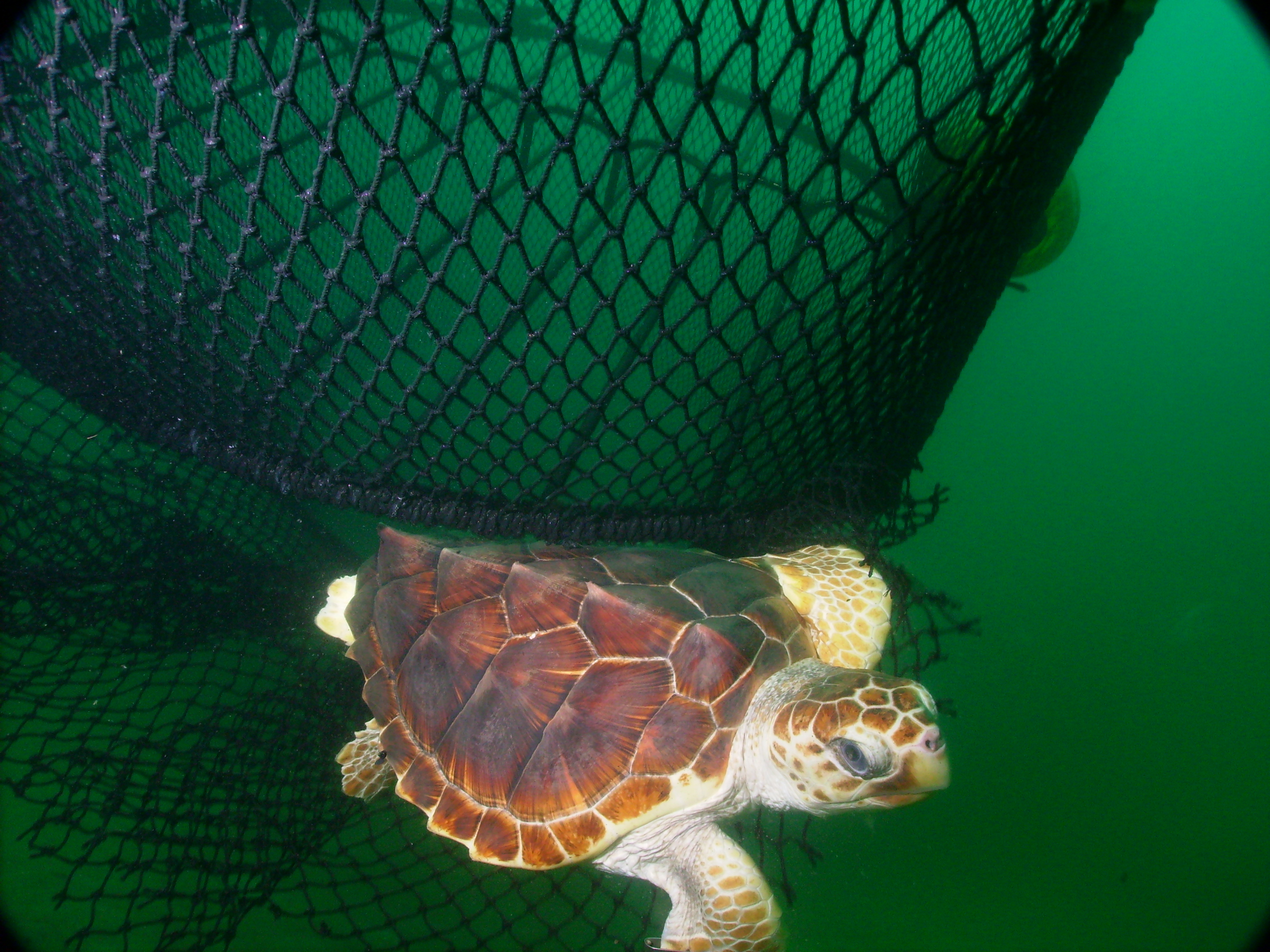Interactions
Loggerhead sea turtles are both predators and prey in the marine
food web. They are
omnivores, meaning they eat both plants and animals, however
they usually prey on animals. Loggerhead
turtles are well known for their big heads and extremely
powerful jaws, therefore they are equipped to consume
hard-shelled prey such as
horseshoe crab
(Duermit, 2007). Other species actually
benefit from the loggerhead turtles eating hard-shelled
organisms because the left over shells can serve as a calcium
source (Duermit, 2007). Loggerhead turtles’ diet also consists of
jellyfish,
sponges,
shellfish,
shrimp and squid
(Department of Energy and Environmental Protection, 2013).
Unfortunately during reproduction, the loggerhead eggs are
highly vulnerable and can serve as a food source for predators
such as raccoons or red foxes. In their adult life the turtles
can be prey for
organisms such as
sharks, and
birds (Duermit, 2007; Department of Energy
and Environmental Protection, 2013).
There are even some organisms,
both plant and animal, that actually live on the shell of the
loggerhead turtles and are known as epibionts (Harding et al., 2011).
Loggerhead turtles can serve as a host to parasitic organisms like the marine
turtle leech (Ozobranchus margoi) (University of
Pennsylvania, 2004). Parasitism is a symbiotic relationship in
which one organism, the parasite, benefits at the cost of
another organism, known as the host, that they are living on or
inside of (Campbell et al., 2008). The marine turtle leech actually latches onto the
loggerhead’s exposed body and uses them as a food source as well as a
place to lay eggs. If a turtle becomes too infested, it will
stop feeding and potentially lead to mortality (University of
Pennsylvania, 2004). Unlike the marine turtle leech, many of the
organisms that live on the loggerhead are not harmful towards
the turtle and just use them as a place to live. Some examples
are gastropod molluscs, which are large snails, from the family
Muricidae (Harding et al., 2011) and
algae (Duermit, 2007). An
organism that has recently been discovered to be an epibiont is
the invasive species Veined Rapa Whelk (Rapana venosa), that use
the loggerhead turtles to migrate to new coastal areas and
disperse their eggs. (Harding et al., 2011).
can serve as a host to parasitic organisms like the marine
turtle leech (Ozobranchus margoi) (University of
Pennsylvania, 2004). Parasitism is a symbiotic relationship in
which one organism, the parasite, benefits at the cost of
another organism, known as the host, that they are living on or
inside of (Campbell et al., 2008). The marine turtle leech actually latches onto the
loggerhead’s exposed body and uses them as a food source as well as a
place to lay eggs. If a turtle becomes too infested, it will
stop feeding and potentially lead to mortality (University of
Pennsylvania, 2004). Unlike the marine turtle leech, many of the
organisms that live on the loggerhead are not harmful towards
the turtle and just use them as a place to live. Some examples
are gastropod molluscs, which are large snails, from the family
Muricidae (Harding et al., 2011) and
algae (Duermit, 2007). An
organism that has recently been discovered to be an epibiont is
the invasive species Veined Rapa Whelk (Rapana venosa), that use
the loggerhead turtles to migrate to new coastal areas and
disperse their eggs. (Harding et al., 2011).
Sadly, the loggerhead turtle
population is currently on decline. Humans play a very large
role in this drop. The leading threat to the turtles are them
accidently getting caught in fishing gear (NOAA Fisheries,
2013). Loggerheads have been caught in a variety of different
types of fishing gear like drift nets or set nets either by
chance, swimming into the net or even by preying on fish that
are trapped in the nets (Echwikhi et al., 2012). While in the
net, the loggerhead often begins to suffer from apnea, which is
a temporary suspension of breathing, causing 60% of the total
captured turtles to die due to drowning (Echwikhi et al., 2012).
Another human caused factor leading to the decline is debris
left in the ocean. The turtles have been known to entangle
themselves in the debris or even digest it (NOAA Fisheries,
2013). Humans have also been harvesting the loggerhead turtle in
areas such as the Bahamas, Cuba and Mexico (NOAA Fisheries,
2013).
Loggerheads have been caught in a variety of different
types of fishing gear like drift nets or set nets either by
chance, swimming into the net or even by preying on fish that
are trapped in the nets (Echwikhi et al., 2012). While in the
net, the loggerhead often begins to suffer from apnea, which is
a temporary suspension of breathing, causing 60% of the total
captured turtles to die due to drowning (Echwikhi et al., 2012).
Another human caused factor leading to the decline is debris
left in the ocean. The turtles have been known to entangle
themselves in the debris or even digest it (NOAA Fisheries,
2013). Humans have also been harvesting the loggerhead turtle in
areas such as the Bahamas, Cuba and Mexico (NOAA Fisheries,
2013).
Links
Facts→